New Mexico Motels
Check out our growing collection of motel postcards from this state.
This page is a work in progress, with all of the accompanying opportunities for misspelling and factual error. If you have any comments, suggestions, or concerns, please feel free to email us.
We're zooming across the interstate from California to Texas, pulling off I-10 in Deming just to get some gas. We only plan to leave a trail of dust after a moment or two, but when you find a Motel Drive, it's wise to drive slowly and get to know the town better. It's around five in the afternoon, no neon in site. But you can bet that, after dark, the galloping horses and pulsating stars are ready to cavort under the broad skies. Take our advice: if you've passed the sunset line and are trying to make time on the highway, pull off the interstate anyway and enjoy the show. Further east, in Las Cruces, we stop by the Townhouse Motel on another aptly named Motel Boulevard. An L shaped complex with red painted doors, the Townhouse is only one story high, but no one seems to care.
![[camera]](camera.gif) Townhouse Motel
Townhouse Motel
![[Motel Americana]](americana.jpeg) Summer 1996: About halfway between Oklahoma City and Albuquerque, Tucumcari is one of those rare towns where the motel lights make you want to get out of the car and walk a while. The strip through town that used to be marked Route 66 is a delight of blinking, glowing, moving color. Having driven along the barbed wire through the mesas and the huge expanses of open land, we agree that it was worth it all just to come here for a while. At this point, we find out the proper pronunciation for the city: two come carry. In Route 66: The Mother Road, Michael Wallis recalls one of the more exotic stories behind the name: "It seems an Apache maiden named Kari, daughter of Chief Wauntonomah, was smitten by Tocom, a handsome young brave. When Tocom was killed by a rival, Kari is said to have stabbed her sweetheart's murderer and then taken her own life with the bloody knife. Wauntonomah was so distraught when he found out his daughter and future son-in-law were both dead, the chief seized Kari's knife and plunged it into his heart as he wailed his dying words, "Tocum! Kari!" Wallis is quick to remind us that more reasonable stories exist to explain the origin of Tucumcari. But surely, there are none more tragically romantic. Thinking on this, our own name presents itself to us. In the falling evening, we discover Motel Americana - or Americana Motel - depending on which side you face. According to a postcard I find in the office, this place used to be one of the Whiting Brothers Motels - a chain with links in Holbrook, Winslow, Flagstaff, and the Continental Divide.
Summer 1996: About halfway between Oklahoma City and Albuquerque, Tucumcari is one of those rare towns where the motel lights make you want to get out of the car and walk a while. The strip through town that used to be marked Route 66 is a delight of blinking, glowing, moving color. Having driven along the barbed wire through the mesas and the huge expanses of open land, we agree that it was worth it all just to come here for a while. At this point, we find out the proper pronunciation for the city: two come carry. In Route 66: The Mother Road, Michael Wallis recalls one of the more exotic stories behind the name: "It seems an Apache maiden named Kari, daughter of Chief Wauntonomah, was smitten by Tocom, a handsome young brave. When Tocom was killed by a rival, Kari is said to have stabbed her sweetheart's murderer and then taken her own life with the bloody knife. Wauntonomah was so distraught when he found out his daughter and future son-in-law were both dead, the chief seized Kari's knife and plunged it into his heart as he wailed his dying words, "Tocum! Kari!" Wallis is quick to remind us that more reasonable stories exist to explain the origin of Tucumcari. But surely, there are none more tragically romantic. Thinking on this, our own name presents itself to us. In the falling evening, we discover Motel Americana - or Americana Motel - depending on which side you face. According to a postcard I find in the office, this place used to be one of the Whiting Brothers Motels - a chain with links in Holbrook, Winslow, Flagstaff, and the Continental Divide.
In Tucumcari, we also visit the Palomino Motel ("Why pay more? Please inspect our rooms. You will stay.") Inside the letters of the word Palomino are tiny light bulbs that surely blinked at one time to attract visitors. Only the outline is visible now. Across the street, the Apache greets us with its two story collection of murals that recall Native American themes. We even find teepees painted along the stairwells. The new owners can't remember how long the artwork has adorned this building. Outside of room 115, a doberman stares warily as I walk past. Further along, we encounter the Buckaroo Motel with its matching chairs and doors.
![[camera]](camera.gif) Palomino Motel
Palomino Motel
![[camera]](camera.gif) Buckaroo Motel
Buckaroo Motel
![[Blue Swallow]](newmexicoblue.jpeg)
Finally, we stop at the Blue Swallow Motel ("100% refrigerated air") and meet a Route 66 institution, Lillian Redman (now deceased). Mrs. Redman arrived in New Mexico by way of covered wagon in 1916, worked as a Fred Harvey Girl in her youth, and received the Blue Swallow as an engagement present in 1958. In our 1996 conversation, she recalled when the highway was paved with cinders because of its proximity to the railroad and expounded upon her belief that we are all travelers in some way. Even into her nineties, she offered a clean room, hardwood floor, and black and white television to road weary travelers for eleven bucks and change. On the back of her postcard, I read: "From 'birth 'til death' we travel between eternities. May these days be pleasant for you, profitable for society, helpful to those you meet, and a joy to those who know and love you best." If you're curious, Blue Swallow represents two ideas: blue stands for truth, while the bird stands for love.
During our Summer 2000 return to the Mother Road, we met Dale and Hilda Bakke, the new owners of the Blue Swallow Motel. Turns out Dale was a licensed electrician employed by the Colorado prison system for nine years. He loved the first seven but grew to dread the increasingly administrative functions of his job. So he picked up, sold everything, and moved the family the New Mexico after hearing about a chance to buy an old motel. "I didn't know it was on Route 66 or anything, only that it was beat up and needed a lot of work." After winning a competitive grant from USWest, he added a phone system to the formerly communication-challenged court, but made sure that the phones would be vintage rotary models. The floors are now carpeted and the walls are freshly painted, but the overall attitude remains the same. Step into the office, pet a fourteen year old cat, grab a postcard, and settle into a nice room. Given all the refurbishment and upgrade, don't be surprised that the price has more than doubled since Lillian Redmond owned the place, and don't be stingy either. This is the best motel on Route 66. Sure, some folks may quibble over the enhancements. Hilda remarks: "We get some purists who complain, 'you should have left the old black and white TVs, you should have left the old stuff.'" Of course, she adds: "we could have left the old creaky mattresses, too . . . we won't make any structural changes, and most people like what we've done to it."
The morning light reveals the Cactus Motel-Camp ("Adults only"). In front of the windowsills, we find yellow boards and the occasional rusty car battery. In the office a sign announces: "used pressure regulators - sale. $5.00 each." Driving west, we hit the Silver Moon at Santa Rosa. As Jenny arranges her shot, I sit in one of those old chairs that support your weight through twin curves of metal. Trucks stream past in a morning thick with sweat. In his 1946, Guidebook to highway 66, Jack Rittenhouse writes: "Santa Rosa is a small village located off to the left here, with a cluster of adobe homes and a mission church clinging to the rocky side of the mesa." Little has changed.
![[camera]](camera.gif) Cactus Motel Camp
Cactus Motel Camp
![[camera]](camera.gif) Silver Moon Motel
Silver Moon Motel
During our Summer 2000 trip, we spend extra time in Albuquerque, cityscape of colorful murals where even the garbage bins are painted with angular coyotes and Zuni symbols. We've got Weird Al Yankovic cranked up in the car stereo; his bizarre stream-of-consciousness trip to the Duke City has fired up our imaginations for our visit for months now. We're cruising down Central Avenue, about eighteen miles of classic Route 66 businesses and some of the best neon in the southwest. Naturally, we stop at the 66 Diner for tasty shakes and some gut-busting frito pie. Then, we're on the road again.
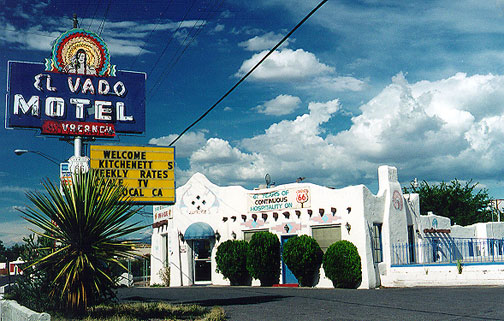
First, we visit the El Vado, our home for the night. This is a true Mother Road landmark, featuring pueblo revival architecture and an owner who loves the old highway. Afterward, the Monterey deserves a brief stop before the sun goes down. By nightfall, we delight in the fact that many of the old businesses have kept the neon vibe alive - Garcia's Cafe and the Avalon Bar downtown are particularly noteworthy. At the De Anza Motel, a dude calls me over to his room. Each part of my introduction - we shoot motel signs for a hobby, we're on a two week vacation, we aren't trying to make a profit from our trip, I teach at a university in San Jose - becomes transformed into a question in an endless conversation loop: "So you're taking pictures of motels? . . . so you're on vacation? . . . so you're not doing this for a business? . . . so you teach college?" We could go on like this for hours ("so, you could go on like this for hours?") but the road awaits.
![[camera]](camera.gif) El Vado Motel
El Vado Motel
![[camera]](camera.gif) Monterey Motel
Monterey Motel
![[camera]](camera.gif) De Anza Motel
De Anza Motel
Jenny insists that we shoot the Bow & Arrow Lodge, even though the owners are pretty ornery about trespassing laws. So she stands in the median, waiting to sync the blinking arrows with the passing motorists, some of which whistle and beep their horns. Same sign at the Tewa Lodge, but the manager's really cool. He's been asked if folks can shoot his sign about a million times. We end up, like so many folks do, at La Puerta Lodge. A doorway to the nearby interstate, it's a place of shadows amidst the brilliant red and green neon lining the adobe facade. Mangy fellows keep their cigarettes tightly locked under sun-cracked wrinkles. Tall trees and bushy weeds grow out of a center courtyard that might have offered a smiling swimming pool years back.
![[camera]](camera.gif) Bow & Arrow Lodge
Bow & Arrow Lodge
![[camera]](camera.gif) Tewa Lodge
Tewa Lodge
![[camera]](camera.gif) La Puerta Lodge
La Puerta Lodge
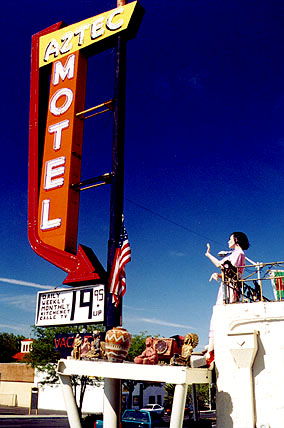 The next morning, we learn that neon alone is not essential for a great motel. After missing it the night before, we stay awhile at the Aztec Motel meeting Mahamed, the owner, and Phyllis, artist-in-residence. Touring the Aztec, you find a cross-cultural melange of broken pottery, old coins, and disparate figurines. But stay awhile, let the shadows depart a bit, and a subtle purpose asserts itself. Not quite an impromptu monument, not quite a love story, this motel is a collaborative exhibition of a mature friendship between two old souls who are determined to create art wherever they find it.
The next morning, we learn that neon alone is not essential for a great motel. After missing it the night before, we stay awhile at the Aztec Motel meeting Mahamed, the owner, and Phyllis, artist-in-residence. Touring the Aztec, you find a cross-cultural melange of broken pottery, old coins, and disparate figurines. But stay awhile, let the shadows depart a bit, and a subtle purpose asserts itself. Not quite an impromptu monument, not quite a love story, this motel is a collaborative exhibition of a mature friendship between two old souls who are determined to create art wherever they find it.
Phyllis turns out to be a retired Michigan State university professor of social work who moved to the Aztec temporarily until she could find an apartment. That was seven years ago. Since then, she has gathered inspiration from her time in southern Italy to transform the motel into a renaissance experience: " I was running a vintage clothing business and I was going through thrift stores collecting material to beautify the outside of my room. It was funny, suddenly, other people started to complain - 'why isn't my room like that?" Phyllis invites us in to room 15, assuring us that this is a rare treat. She gets a lot of pushy reporters who ask tacky questions like, "you're not ashamed of your room, are you?" No, she responds, it's a matter of privacy.
Duck under an arch that appears to have been inspired by the Alahambra and you enter her library, bedroom, and sanctuary: "When I retired, I wanted to live in an art colony . . . but I found the colonies to be too commercial." A far cry from the colonies, she found Aztec in crisis: "the city was ready to tear it down; it was filled with drug dealers and hookers. Mahamed and I used to be out in the evening with machetes and stun guns, but he's intent on making this a decent place."
Sipping strong coffee and jawing down tasty cashews imported from Africa, Mahamed and I chat about the Aztec, the only site along Central Avenue on the National Register of Historic Places. And, naturally, we chat about Phyllis: "She's our Mother Teresa," he says without a trace of doubt.
![[camera]](camera.gif) Mahamed and Phyllis
Mahamed and Phyllis
![[camera]](camera.gif) Chatting with Phyllis
Chatting with Phyllis
![[camera]](camera.gif) Aztec Wall
Aztec Wall
We arrive in Gallup, with its five mile stretch of road cutting through dozens of aging motels. Our first stop is the Roadrunner. Next to the pool, I see chili plants growing almost like weeds from under a rock. Closer inspection reveals, however, that they are cultivated with great care. The motel features crisscrossed patterns of deep red against its pink walls - and, of course, a picture of a roadrunner on its sign. We've yet to see a real roadrunner around these parts, but judging by the postcards available at every exit, the birds are much smaller than they appear on cartoons.
![[camera]](camera.gif) Roadrunner Motel
Roadrunner Motel
Heading west through town, Jenny catches sight of the Blue Spruce Lodge. Surrounding the roof is a slash of purple neon, while next to every door we find an ornate lamp edged with green plastic and iron swirls. On the road, pools of gasoline create drifts of almost incandescent color marred only by occasional raindrops. At the Cactus motel (where there is no real cactus to be seen), a pack of children play in an empty parking lot. Only the Log Cabin Motel is pretty much as it sounds - two rows of lavishly painted dark red cabins, edged in white. Inside, a large bedroom separates a bathroom on one end and a shower on the other. Rain falls from the overhang as we decide to keep going out of town toward the fabled teepees of Holbrook, Arizona.
![[camera]](camera.gif) Blue Spruce Lodge
Blue Spruce Lodge
![[camera]](camera.gif) Cactus Motel
Cactus Motel
![[camera]](camera.gif) Log Cabin Motel
Log Cabin Motel
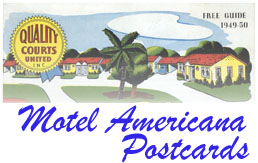
Click the  button to enjoy the full-size view.
button to enjoy the full-size view.
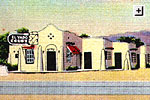
|
|
El Vado Court
A GOOD Court
Tile showers - Phone in every room - Fire Proof and Sound Proof. Adjoining golf course and Bathing Beach. U.S. Highway 66. 2500 W. Central Ave. Albuquerque, New Mexico. Phone 4910. Dan Murphy, Proprietor
|
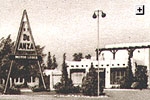
|
|
De Anza Motor Lodge
Named after Lieutenant Colonel Juan Batista de Anza, who was the Spanish Governor of New Mexico, 1778-1789. Designed to please the discriminating guest. Offering in Albuquerque to the motorist modern convenience and satisfying comfort. Telephone in every room.
|
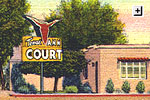
|
|
Texas Ann Court
2305 W. Central - Albuquerque, N. Mex. Telephone 2-3880. Mr. and Mrs. M. Mossman, Owners.
|
Return to the lobby.
All photographs copyright © Jenny
Wood. Text copyright © Andy Wood.
![[Motel Americana]](americana.jpeg) Summer 1996: About halfway between Oklahoma City and Albuquerque, Tucumcari is one of those rare towns where the motel lights make you want to get out of the car and walk a while. The strip through town that used to be marked Route 66 is a delight of blinking, glowing, moving color. Having driven along the barbed wire through the mesas and the huge expanses of open land, we agree that it was worth it all just to come here for a while. At this point, we find out the proper pronunciation for the city: two come carry. In Route 66: The Mother Road, Michael Wallis recalls one of the more exotic stories behind the name: "It seems an Apache maiden named Kari, daughter of Chief Wauntonomah, was smitten by Tocom, a handsome young brave. When Tocom was killed by a rival, Kari is said to have stabbed her sweetheart's murderer and then taken her own life with the bloody knife. Wauntonomah was so distraught when he found out his daughter and future son-in-law were both dead, the chief seized Kari's knife and plunged it into his heart as he wailed his dying words, "Tocum! Kari!" Wallis is quick to remind us that more reasonable stories exist to explain the origin of Tucumcari. But surely, there are none more tragically romantic. Thinking on this, our own name presents itself to us. In the falling evening, we discover Motel Americana - or Americana Motel - depending on which side you face. According to a postcard I find in the office, this place used to be one of the Whiting Brothers Motels - a chain with links in Holbrook, Winslow, Flagstaff, and the Continental Divide.
Summer 1996: About halfway between Oklahoma City and Albuquerque, Tucumcari is one of those rare towns where the motel lights make you want to get out of the car and walk a while. The strip through town that used to be marked Route 66 is a delight of blinking, glowing, moving color. Having driven along the barbed wire through the mesas and the huge expanses of open land, we agree that it was worth it all just to come here for a while. At this point, we find out the proper pronunciation for the city: two come carry. In Route 66: The Mother Road, Michael Wallis recalls one of the more exotic stories behind the name: "It seems an Apache maiden named Kari, daughter of Chief Wauntonomah, was smitten by Tocom, a handsome young brave. When Tocom was killed by a rival, Kari is said to have stabbed her sweetheart's murderer and then taken her own life with the bloody knife. Wauntonomah was so distraught when he found out his daughter and future son-in-law were both dead, the chief seized Kari's knife and plunged it into his heart as he wailed his dying words, "Tocum! Kari!" Wallis is quick to remind us that more reasonable stories exist to explain the origin of Tucumcari. But surely, there are none more tragically romantic. Thinking on this, our own name presents itself to us. In the falling evening, we discover Motel Americana - or Americana Motel - depending on which side you face. According to a postcard I find in the office, this place used to be one of the Whiting Brothers Motels - a chain with links in Holbrook, Winslow, Flagstaff, and the Continental Divide.
![[camera]](camera.gif) Townhouse Motel
Townhouse Motel![[Blue Swallow]](newmexicoblue.jpeg)

 The next morning, we learn that neon alone is not essential for a great motel. After missing it the night before, we stay awhile at the Aztec Motel meeting Mahamed, the owner, and Phyllis, artist-in-residence. Touring the Aztec, you find a cross-cultural melange of broken pottery, old coins, and disparate figurines. But stay awhile, let the shadows depart a bit, and a subtle purpose asserts itself. Not quite an impromptu monument, not quite a love story, this motel is a collaborative exhibition of a mature friendship between two old souls who are determined to create art wherever they find it.
The next morning, we learn that neon alone is not essential for a great motel. After missing it the night before, we stay awhile at the Aztec Motel meeting Mahamed, the owner, and Phyllis, artist-in-residence. Touring the Aztec, you find a cross-cultural melange of broken pottery, old coins, and disparate figurines. But stay awhile, let the shadows depart a bit, and a subtle purpose asserts itself. Not quite an impromptu monument, not quite a love story, this motel is a collaborative exhibition of a mature friendship between two old souls who are determined to create art wherever they find it.



